Step-by-step instructions for novice summer residents: how to tie cucumbers correctly, the best ways
Thanks to tying, air exchange increases, the growth and productivity of cucumbers increases. We will tell you in detail about the types of structures and give step-by-step instructions for their manufacture.
The content of the article
Why tie cucumbers
The cucumber tying system is essential for a high yield.
Why tie a cucumber:
- due to the support, the bush is formed correctly;
- a neatly formed plant is easier pinch;
- the development of lateral shoots is enhanced;
- air exchange increases;
- compact bushes are formed;
- watering the plant is facilitated;
- contact of sick and healthy shoots is excluded;
- convenient to pick the fruit.
The stems creeping on the ground quickly dry out or rot. If the bush itself begins to haphazardly trudge in a vertical direction, the untied lashes may break off under the weight of the fruit.
Types of garters
For tying cucumbers, a special structure is built. This process does not require a lot of time and labor. The design will not take up space in the garden, but, on the contrary, will help to form cucumber bush and free up space. Summer residents use different methods of tying a cucumber, each of which is horizontal or vertical.
Horizontal
This type of tying is traditional. 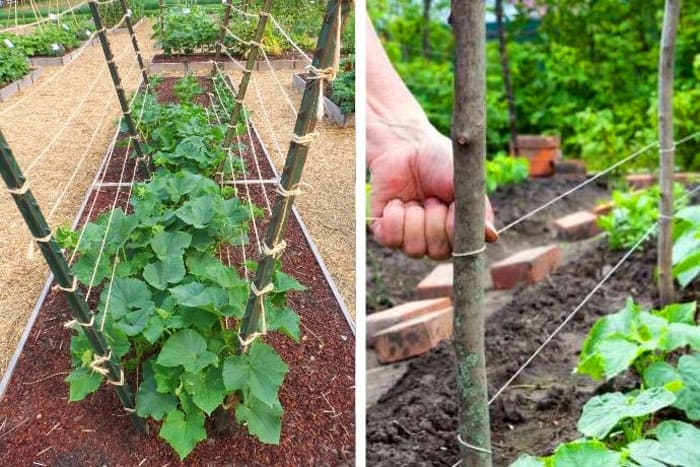
Basic steps for assembling the structure:
- Take a support 150-200 cm and drive in on the two long sides of the bed so that they hold firmly.
- Observe the distance between the supports 40-50 cm.
- Take a strong rope and pull it evenly between the posts.
- Make the distance between the rope rows 10-15 cm.
After manufacturing the structure, young shoots are sent to the lower tier. As it grows, the plant itself will crawl along the taut rows of rope and form.
Important! Tiers of rope are pulled tightly parallel to each other.
The advantages of this method:
- the design is easy to manufacture, even a beginner can handle;
- does not require effort in the formation of a bush.
The only drawback of this method is that when the cucumber whip reaches the first horizontal support, it does not try to drag itself up, but winds along it. You have to guide the escape manually.
Vertical
The vertical formation of the bush is a popular way of garter cucumbers among experienced summer residents. 
The difference between this type and the horizontal is in the arrangement of the ropes.
Step-by-step instructions for assembling the structure:
- Take two supports 200 cm high and drive in the center of the short sides of the bed.
- Using a rope and a crossbar, connect the pillars to each other. You should get a U-shaped design.
- Plant cucumbers under the crossbar at a distance of 30 cm.
- When the plants begin to curl, take the tape and, wrapping it around the stem, pull it to the crossbar and tie it.
- The cucumber will cling to the mustache and grow upwards along the vertically launched fabric tape.
The advantages of the vertical tying method:
- easy to implement;
- saves space on the site;
- does not require additional efforts to form a bush.
The disadvantage of the vertical method is that with a flimsy installation, the structure will collapse and damage everything landing.
Important! The horizontal bar is often replaced with sturdy rope.In this case, it is pulled tightly so that it can support the weight of an adult plant.
Garter methods
Methods for tying a cucumber are variations of the horizontal and vertical look. Each gardener chooses the method that suits him best. The choice depends on the time and materials available.
V-shaped
The V-shaped version refers to the vertical types of tying. The difference lies in the possibility of forming a divided bush.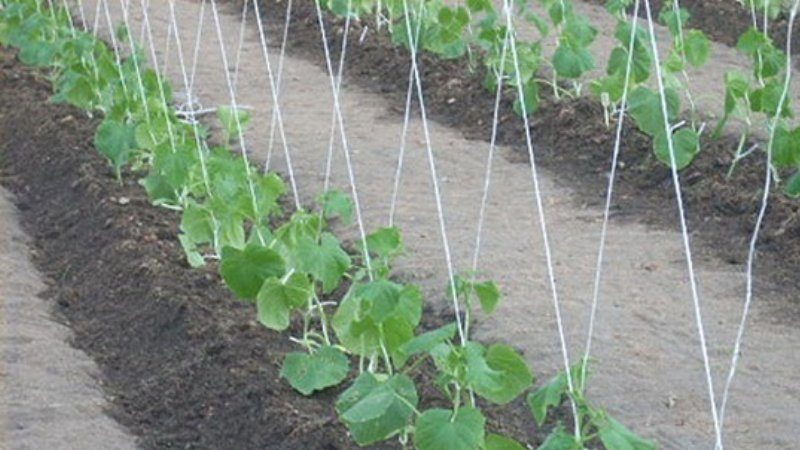
When using this method, a structure similar to the vertical tying method is built.
Tying steps:
- Take two fabric ribbons and tie at a distance of 20 cm from each other above the cucumber bush.
- Tie the ends of the tape at the base.
- Place the main shoot on one tape and the large side shoot on the other.
The plant itself will cling to the tape and grow upward.
Important! With V-shaped tying, the thickening of the base of the bush decreases, the plant is less sick and receives a sufficient amount of light.
Mesh
The basis of the design with the mesh method is the mesh. In garden stores, there is a huge selection of special nets made of metal and plastic. They are intended not only for cucumbers, but for all climbing plants. 
The mesh is a horizontal and vertical garter at the same time. The mesh is placed between two supports or in another convenient way. The cucumber is directed to the frame, and in the process of growth it braids the cells. The plant feels free, as it easily reaches all the cells.
The advantages of the mesh method:
- robust construction;
- durable;
- does not require strength to form a bush.
The disadvantage is the time and labor required to find and install the grid.
In an arc
Garter on arcs - an alternative method of the horizontal version. Arcs made of plastic or metal and a rope are used as the basis of the structure. 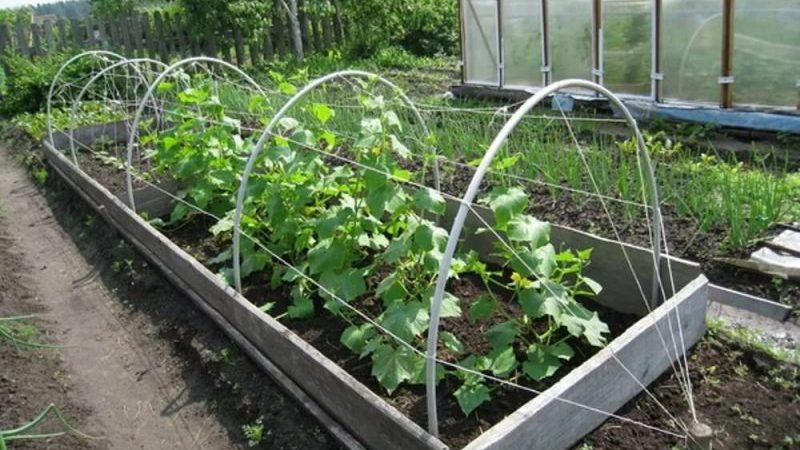
Step-by-step instruction:
- Take the arcs and place them at a distance of 80-90 cm from each other along the ridge.
- Connect the arcs around the circle with ropes.
- Place the rope tiers parallel at a distance of 20 cm.
- Plant the plants in the middle along the ridge.
- After the start of branching, direct the bush to the rope tiers.
For greater strength, the structure is reinforced with support on the sides of the garden.
The advantage of this method is the ability to cover crops with covering material. Therefore, this option is relevant for regions with sharp drops in day and night temperatures.
The disadvantage of this method is that the manufacture of the structure takes a lot of time.
Pyramid
This method is also called "herringbone garter". 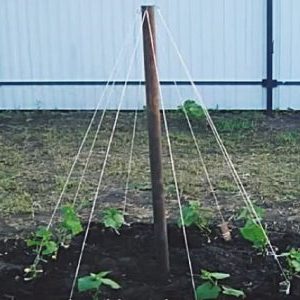
The basis of the structure is a pillar. It serves as a support, therefore it must be strong and stable.
Stages of tying a pyramid:
- Install a support post with a height of at least 1.5 m.
- Tie the ropes to the top of the support. The number of ropes is equal to the number of plants. The length of the rope is equal to the height of the post.
- Lower the ropes to the ground and tie them to the bases of the plants.
You don't need to do anything else. The cucumber itself will braid the rope until it reaches the top.
On the trellis
A trellis is a grate with a frame that serves as a support for plants. It is made from metal or wood.
Tapestries come in different shapes and types. This method of tying a cucumber turns out to be not only functional, but also beautiful. 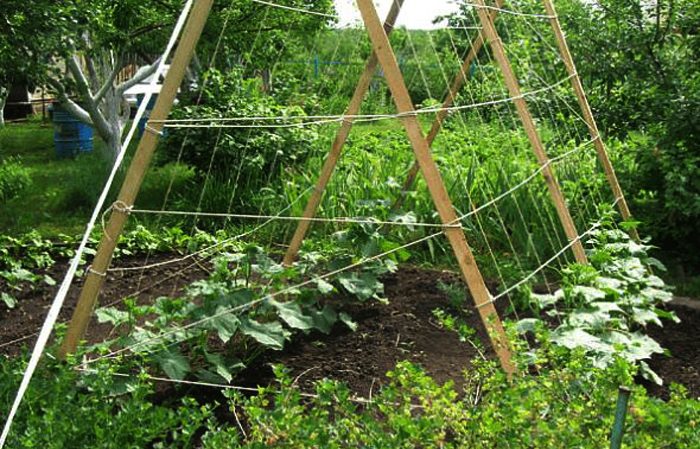
Usually, the structure is located in an A-shaped or U-shaped form. Cucumbers are planted at the base and allowed to braid the net. This method is similar to the mesh one.
The advantage is structural strength. The only drawback is labor input.
On pegs
The peg tie is suitable for low growing varieties.
The construction is based on wooden pegs. They are installed next to each bush. The length of the peg is measured based on the characteristics of the variety. It should be equal to the maximum length of the cucumber stem.
The main garter is positioned along the center stem. Ropes are also put to the rest of the shoots.
On the ladders
The main structural element is a wood or metal support, resembling a ladder. Do it yourself or buy it at a garden store. This method is similar to tying on pegs.
The structure is placed near each bush. The plant in the process of growing relies on it and grows upward.
Unusual methods
Cucumber lovers from all over the world continue to modernize old and well-known garter methods and along the way are developing new, original ways of forming a cucumber bush.
Cucumbers in a barrel
The barrel serves as the basis for the design Plants are planted in a container filled with soil. Due to the force of gravity, growing, the shoots begin to hang over the edges and grow vertically downward. This method saves space on the site.
Cucumber tree
The basis of tying in the formation of a bush in several shoots in such a way that it becomes like a tree... For this, a structure with horizontal bars is built. A rope is fixed on it, which will connect the main stem and the crossbar. Ropes are also attached to the side lashes and spread along the sides. After the education of women ovaries lateral stems neatly lead to the main one. The angle between the central and lateral shoots is left 60 °, so the plant is not injured. The mustache from the central shoot is twisted around the lateral one, and the remaining processes are removed.
Plastic bottles
In this method, a plastic bottle is used as a fixation of the cucumber stem to the structure. The bottle is cut into strips of the desired size. A strip is wrapped around the stem and the structure at the attachment point, the ends of the plastic are connected with a stapler.
Natural trellis
The fence acts as a basis for tying. Plants are planted along the structure, and if it is a chain-link, it is enough to direct the cucumber, and he himself will begin to braid the net. And if the fence is wooden or metal, they stretch the ropes from the upper edge to the bases of the bushes, and the cucumbers begin to braid them.
What needs to be prepared in advance
The list of materials that will be needed for the manufacture of the structure depends on the chosen method of tying, the capabilities of the gardener and the characteristics of the site.
Basic materials for popular types of tying:
- metal or wooden posts;
- twine or other strong rope;
- strips of cotton fabric;
- metal or plastic mesh;
- arched arcs;
- scissors.
To help summer residents in gardening stores, there are special clips for fixing the plant. And for large-scale farms, a stapler will be useful, which is charged with a garter belt.
How to tie cucumbers correctly - step by step instructions
Compliance with the rules of tying increases the productivity of the plant and improves the quality of the crop.
Important! Tying begins when the plant has reached a height of 30 cm and has at least four true leaves.
Features of tying a cucumber:
- use a soft cotton cloth so as not to damage the shoot;
- the strapping loop should not be tight, otherwise the stem will break;
- control the process of bush formation and promptly guide the top around the support;
- do not pull the ropes tightly when tying vertically;
- overgrown bushes are tied up carefully so as not to damage the stem.
Failure to comply with the rules leads to injuries to the bush, which are not immediately noticed. Subsequently, such a plant can become infected with a fungus.
Outdoors
Outdoor garters are especially important for plant development because:
- a tied bush throws out long shoots, on which more inflorescences appear and more fruits are tied;
- a plant affected by a fungus or viral infection brings healthy shoots upward, avoiding the spread of the disease;
- a vertically tied bush takes up less space on the site;
- it is more convenient to pick fruits without bending over to the ground.
Without a garter, cucumbers in the open field do not allow long shoots, thicken, rot and dry out, the stems break off under the weight of the harvest, and the fruits curl, wrinkle and lose their presentation and taste.
In a greenhouse, greenhouse
Reasons for tying a cucumber in greenhouse:
- plants get more sunlight;
- air exchange between bushes increases, and plants get sick less;
- lateral shoots are formed more actively, the productivity of the bushes increases.
If in the open field they use traditional methods of tying, then in the closed field they use other methods.
Methods for forming a cucumber in a greenhouse:
- Dazzling cucumbers. This method is based on the vertical garter method. The main stem is fixed on a support, and all lateral shoots and whiskers located above 50 cm from the ground are removed. Thus, the central stem is strengthened and the prevention of fungal diseases is carried out.
- Forming in a polycarbonate greenhouse. The fabric is cut into strips of length equal to the height of the greenhouse. Fix them on the metal profile of the structure. For each plant, they tie their own rope and guide the cucumber along it. In the same way, instead of ropes, long stakes are used, sticking them into the ground near the bushes.
Tips from experienced summer residents
There are many options for tying cucumbers. Each of them has its own pros and cons.
Tips from experienced summer residents:
- Tie up in the evening or morning hours so that accidental damage on the stem has time to dry out before the scorching sun.
- Tie the side shoots to a separate rope. If this is not done, they will begin to curl around the central stem and harm it.
- Pinch the top. When the plant grows over 2 m, it begins to cast a shadow, which slows down the growth of other cucumbers.
- For one of the horizontal methods, use any rope, and for vertical tying, use a piece of fabric 2-3 cm wide.
Mistakes to Avoid
Mistakes when tying cucumbers:
- the use of thin threads;
- too tight contraction;
- early or too late tying up;
- too frequent bandaging of new shoots.
Conclusion
How to tie up cucumbers, the site owner decides on his own. Some attach ropes to the fence and plant cucumbers along it in a checkerboard pattern. If the cucumbers grow in the middle of the site, trellis attachments are made. The main thing is that the chosen method suits in terms of labor intensity and materials.
do not braid cucumbers, but are attached with a mustache, that is, you need to braid the vine around the support with your hands